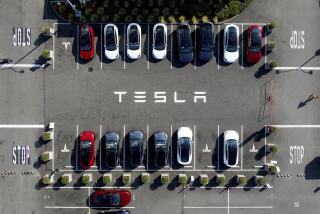U.S. Car Companies’ Reactions Should Be Interesting, Analysts Say : Yen’s Rise Means Japanese Cars Will Cost More
- Share via
One thing is certain about the auto outlook for 1988: Japanese vehicle prices will rise.
An overall boost of 5% is probable for the year, and an increase of 8% to 10% is possible, according to many auto industry analysts.
So U.S. buyers could pay up to $800 more for 1988-model Japanese cars than they paid for similar 1987 models. The cause of this is the drop in the dollar’s value compared to the Japanese yen. A cheaper dollar obliges Japanese auto makers to charge more dollars per car to earn the same amount of profits in their own currency.
Since August, 1985, the dollar’s decline has helped push up prices of Japanese imports by 26%, an average of $3,200 per car, according to estimates by J. D. Power & Associates, an auto marketing research firm in Westlake Village. Comparable prices of U.S. cars went up 18%, an average of $2,200 per car.
“The big question” in 1988 is how American manufacturers will respond to these price increases on Japanese cars, said John Hammond, a Power & Associates analyst. Japanese price increases offer U.S. car companies a chance to undersell foreign competitors and regain some of the market share lost in recent years, Hammond said.
Early indications are that U.S. auto makers are cutting some prices and raising others, with the cuts applying to slower selling cars and the increases to popular models. Some of the cuts are direct rollbacks, such as those on Chrysler Corp.’s Omni-Horizon America subcompact and Reliant-Aries compact cars. Other price reductions, such as those on about half of General Motors Corp.’s 1988-model fleet, are achieved through increasing the amount of standard equipment in new cars without increasing their retail costs.
Sales Decline Predicted
There’s the possibility of an auto-price war in 1988, especially if vehicle sales appear to be falling significantly below the 1987 level of 15.2 million cars and trucks sold--which was 7% below the record 16.3 million vehicles sold in the United States in 1986.
Many analysts and auto-industry officials are predicting a sales decline, perhaps by 500,000 cars and trucks. Others believe that the market will be flat, even though “flat” in this case would be good for the industry: Auto makers rarely sell 15 million or more cars and trucks a year in the United States.
The Department of Commerce is bucking the industry consensus by predicting U.S. sales of 15.6 million cars and trucks this year. But most of the department’s figures and estimates were arrived at before the Oct. 19 stock-market collapse and, as a result, are viewed by some skeptics as being too optimistic.
Auto-industry analysts and officials universally predict a continuation of rebates, low-interest loans and other sales incentives.
Incentives May Increase
Japanese and European auto makers have traditionally held back from such incentive campaigns. Mostly because of their exchange rate-driven price increases, though, foreign auto officials are beginning to find selling schemes more appetizing.
“If we have to use incentives, we are prepared to use them,” said Bjorn Ahlstrom, president and chief executive of Volvo North America Corp. Ahlstrom said he expects a modest decline in overall U.S. auto sales in 1988. But the company usually has been able to move through slow periods without sales gimmicks because of Volvo’s reputation for quality and durability, Ahlstrom said.
Still, it’s a buyer’s market this year. Dealers on the West Coast have eliminated lucrative markups on Japanese vehicle stickers--a big reason Japanese car and truck sales have remained strong despite increases in base prices. Such dealer markups, or “ADMs” as they are known in the business, have ranged from $500 to $2,000 on Japanese cars.
Some hefty ADMs continue to show up on the stickers of Japanese cars sold on the East Coast, particularly in the Mid-Atlantic region. East Coast customers are increasingly reluctant to pay the ADMs, and the dealers are more willing to eliminate those charges.






